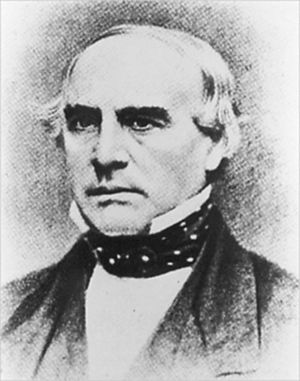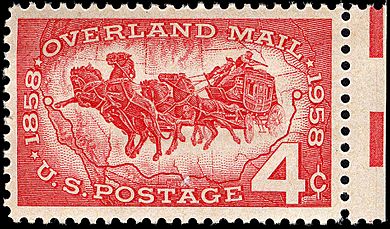John Butterfield (businessman) facts for kids
Quick facts for kids
John Butterfield
|
|
|---|---|
 |
|
| Born | November 18, 1801 Berne, New York, U.S.
|
| Died | November 14, 1869 (aged 67) Utica, New York, U.S.
|
| Resting place | Forest Hill Cemetery Utica, New York, U.S. |
John Butterfield (November 18, 1801 – November 14, 1869) was a transportation pioneer in the mid-19th century in the American Northwest and Southwest. He founded many companies, including American Express which is still in operation today. The Butterfield Overland Mail Company was the longest stagecoach line in the world. The line operated from 1858 to 1861 on the Southern Overland Trail and established an important connection between the new state of California and the government and economy of the contiguous eastern states.
Early life
John Butterfield was a descendant of Benjamin Butterfield, who brought his family from England to the Massachusetts Bay Colony in 1638. His father, Daniel Butterfield, lived at Berne, New York, on the Van Rensselaer Manor, near Albany. In 1822 Daniel married Malinda Harriet Baker. John was born November 18, 1801, in Berne. He attended schools near his boyhood home, but his education was meager. He was employed in the staging business at an early age.
Business ventures
He started stage lines based in his hometown of Utica, New York.
He soon expanded his transportation empire.
John became aware that there was a need to ship parcels (express) by his varied transportation companies.
Because of the pioneering success to establish an express company, other entrepreneurs in upstate New York, not far from John Butterfield's home in Utica, also started express companies by using Butterfield's vast transportation network. Henry Wells was from Auburn, NY (80-miles from Utica), and William Fargo was from Pompei, NY (50-miles from Utica) and their express companies of Wells & Co., and Livingston, Fargo & Co. became competitors of Butterfield, Wasson & Co. Butterfield saw the benefit of forming one company by consolidating the three separate companies. In 1850, The American Express Company was formed from the three companies into one consisting of two subdivisions. The company's subdivision of Wells, Butterfield & Co. would control the express business from Buffalo, NY, to the east, and the subdivision of Livingston, Fargo & Co. would control the express business from Buffalo to St. Louis, Missouri.
John Butterfield’s Overland Mail Company
The Resource Study Act, to designate the Butterfield Trail as a National Historic Trail, was authorized under the Omnibus Public Lands Management Act (Public Law 111-11) signed by President Barack Obama on March 30, 2009. The act was completed and in June 2018 the bill was presented to Congress by Arkansas Senator John Boozman. Kirby Sanders was the consulting historian and lead researcher for the Butterfield study for the National Park Service.
Congressional authorized researcher Sanders put into perspective Wells, Fargo & Co.’s only direct involvement with the Butterfield Overland Mail Company. He stated “Wells Fargo may have run a ‘trunk route’ off the Butterfield [Trail] in LA [Los Angeles] but it was NOT Butterfield per se.” The line was very expensive and cost $3,500,000 to build and maintain. Some of the money was borrowed from the banks of express companies such as Adams Express and Wells, Fargo & Co. Express. William B. Dinsmore, who was also president of Adams Express Co., was the second largest stockholder and was Vice President of Butterfield’s Overland Mail Company. The largest lender may have been Wells, Fargo & Co. Express, since they were the most successful of the express companies.
Ownership of the six-year contract for John Butterfield’s Overland Mail Company was by stockholders only and therefore any ownership was as stated on the stock certificates. Nowhere in the six-year contract, with all its various changes from 1858 to 1864, is the name of Wells, Fargo & Co. to be seen.
In the late 1960s, some historians tried to make the case, through deductive reasoning only, that Wells, Fargo & Co. was an active part of Butterfield’s Overland Mail Company.
It wasn’t until 1867, five years after Butterfield ceased operations on the Southern Overland Trail, that Wells, Fargo & Co. entered the staging business when they scraped off the name on the transom rails of the Pioneer Stage Line and added their own. The line was operating on the western section of the Central Overland Trail.
Legacy
His son, Daniel Adams Butterfield (1831–1901), was a Union general in the American Civil War, and Assistant U.S. Treasurer. Daniel is credited with creating the bugle call Taps, a variation of a bugle call known as the Scott Tattoo, in 1862.
Butterfield died on November 14, 1869, at his home in Utica. Butterfield was buried in Forest Hill Cemetery in Utica New York, where he lived when the established his first stage coach line.
See also


